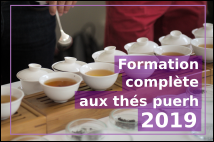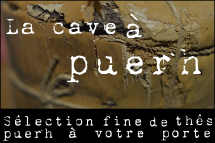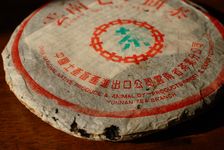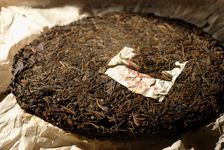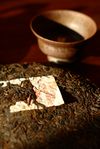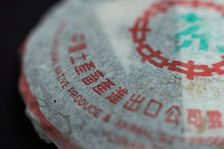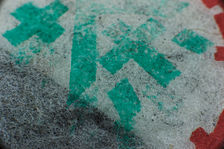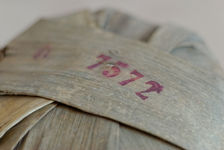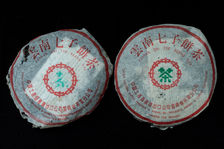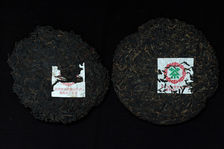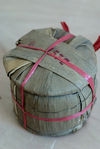 This page is not a real translation but just an automatic translation generated by computer of the original article, written in French language! Its not good... but better than nothing!
This page is not a real translation but just an automatic translation generated by computer of the original article, written in French language! Its not good... but better than nothing!Want to help us do diffuse puerh tea culture in english, by providing a better (or corrected) translation?
Please contact us!

The Shui Lan Yin 1997 (97 水蓝 印), literally Brand aquatic blue or blue water , is undoubtedly one of the great puerh (Pu Er tea) 90s. But this cake, which takes its name from the stunning color wash What took the time tea character (茶) printed in the center of the package is also a puerh (Pu Er tea) that will particularly pours ink from tea lovers.
Not one but two Shui Lan Yin
To understand this tea and not get lost, we must first know that there's, next to the multitude of copies, two different real Shui Lan Yin on the market (and even three), which in from blue-green character in the center do not have much to do with each other. Many indeed mix these two discs, including written and used as passages from the book of Deng Shi Hai on the first Shui Lan Yin to talk about the second, making the history of this increasingly confused tea.
The first Shui Lan Yin, a counterfeit from the 50s
The first Shui Lan Yin arrives on the market in Hong Kong in the 90s, and was probably made so famous by the second book of Deng Shi Hai on puerh (Pu Er tea) teas since 1950. This tea, whose packaging is one of Cha Chi Tse Been CNNP 80s is not only remarkable for the faded color of the character tea (茶) in the center of the box, which earned him his name among collectors , but many other details.
The weight of the cake first, 400 grams, where one would expect to 357g, the paper used for packaging different then the paper used by Menghai Tea Factory, poor print quality and inks used, which again does not comply with productions of this period, but also and especially the very low compression of the cake with leaves crumble barely touched. All of which have been controversial and tend to show that this cake is a fake, or at least has never been out of Menghai Tea Factory.
In 2004 Deng Shi Hai, former Taiwanese specialist teas shows one of these patties Zou Bing Liang and Lu Guo Ling, respectively master assembler and vice director of Menghai Tea Factory, confirming him as the plant has never produced this tea during their stay, or at least not between 1984 and 1997. For Deng Shi Hai, which is much discussed on this cake, it would have actually been pressed in the 80s, not in Yunnan but in Burma, from sheets from their 50s.
Lack of holding leaves and come to the age of tea used, about thirty years, and the lack of material "sticky" leaves this age. When a unique flavor character of tea, it would be due not only to the age of the tea, but also the origin of the leaves. Deng Shi Hai, who knows very well the teas before 1950, sees indeed similarities with the famous Fu Lu Yuan Gong Cha , one of her favorite teas he will constantly try to unravel the mystery, making it that it is possible that the leaves come from Fengqing, the presumed origin of the Fu Lu Gong.
The second Shui Lan Yin, a 7542 produced by Menghai Tea Factory in 1997
The second Shui Lan Yin, before us today, as shown in Hong Kong in the 90s can about the same time as the first. Such as this, it is remarkable for the faded color of nature tea (茶) in the center of the package, but careful observation of the packaging shows many differences between the two patties. The first Shui Lan Yin probably been compressed in the 80s and resumes layout CNNP these years, including the line "YUNNAN Beeng TSE CHI CHA" pinyin longer than the Chinese character version, where on the Shui Lan Yin 1997, in accordance with other productions of the 90s (such as Brand Oranges), these two lines are the same length. But it is especially the opening of the package that we are faced with the leaves to look radically different.
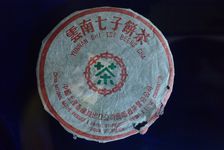
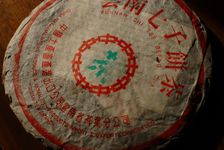
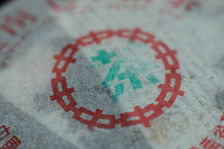
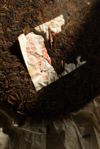
- 1.Packing a cake Menghai Tea Factory 80s
- 2.Racing Shui Lan Yin 1997
- 3.Racing Shui Lan Yin 1997 Detail
- 4.Shui Lan Yin 1997 cake
For it is indeed a different tea and behind the second Shui Lan Yin is a raw puerh (Pu Er tea) produced by Menghai Tea Factory in 1997 from the famous 7542 recipe. What assign unique color 茶 character on the packaging of this rare series of wafer produced in 1997? It is difficult to have a sure answer. Some attribute this color to a new print related to a poor quality ink use default, which seems quite possible.
But we can also think of quite a deliberate "mistake" from Menghai Tea Factory since 1996 that the fate of communist standards, and introduces different packaging, or any private control of Hong Kong. With the opening of the company, Menghai Tea Factory accepts indeed more private orders, especially for tea houses in Hong Kong, and it is quite conceivable that the Shui Lan Yin 1997 is a series Special produced to meet one of these tea house and enjoy the reputation of the first Shui Lan Yin popular in the 90s.
This hypothesis of a voluntary production of a special package to aquatic blue series is also supported by the existence of a third cake blue water less known, but not raw fermented, produced by the Menghai Tea Factory same period as the Shui Lan Yin 1997. But it also explains the special quality and uniqueness of this series of 7542. For what this tea has more striking is not the packaging but its quality and excellent maturation.
Shui Lan Yin 1997, a large tea 90s
tea produced by Menghai Tea Factory just after the 1996 reform
Built in 1939 in the region under the name of Menghai Fohai, the plant becomes factory state with the passage of China under the communist regime and is renowned Menghai Tea Factory in 1959. It will produce from one of the most famous teas and the most sought modern history puerh (Pu Er tea) tea.
True to communist standards, different state factories do not have (or at least not used or very little) their own brands before 1996, and all the cakes were then sold by the company's unique state China National Native Produce & Animal By-Products Import & Export Corporation (CNNP). These teas are all packed and packaging standard of the company, whatever the nature of the tea, the year of production or factory where the tea is released.
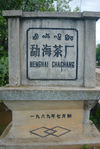
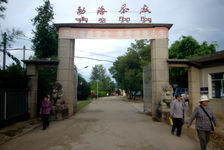
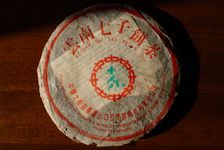
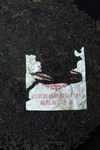
- 1.Menghai Tea Factory
- 2.Input Menghai Tea Factory in 2009
- 3.Racing Shui Lan Yin
- 4.Nei Fei Menghai Tea Factory of Shui Lan Yin 1997
If nothing differentiates the pack, the factory that produces the tea is usually stated in small print at the bottom of Nei Fei, this small piece of paper inserted between the sheets at the heart of the plate, but also on the Big Ticket, which accompanies Jian (baskets) containing 12 tea tong (64 wafers).
Among the various state factories since the 50s are responsible for the production of puerh (Pu Er tea) tea, tea out of Menghai Tea Factory are the most sought amateurs and such that Lan Shui Yin 1997, are generally regarded as being higher quality.
In 1996, a year before pressing the Shui Lan Yin, Menghai Tea Factory is reformed and becomes Menghai Tea Industry Company Limited , which marks a turning point for the company and will be accompanied by the departure of two grans name uisne Zou Liang Bing and Lu Guo Ling. Will follow a progressive distancing face CNNP standards, the use of more systematic brand Da Yi and ultimate abandonment of conventional packages to benefit specific new packaging factory as eg < a href = 'http://www.puerh.fr/article/da_yi_rouge.htm' target = '_Blank'> Da Yi Red or Violets, who are appearing at the same time as the Shui Lan Yin.
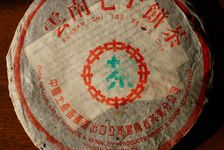
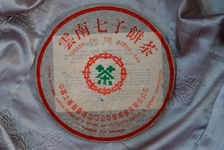
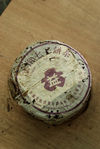
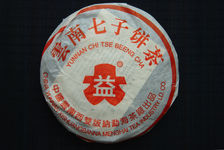
- 1.Shui Lan Yin 1997
- 2.Classic Racing Tse Chi Cha Beeng CNNP end 90
- 3.Da Yi Violette early 2000
- 4.Da Yi early 2000 Red
Behind the packaging a CNNP puerh (Pu Er tea) recipe 7542
Although all Beeng Tse Chi Cha outputs Menghai Tea Factory in the 90s are similar, and share many of the same for packaging teas that make these cakes are not alike. This may seem strange to tea lover today, but radically different teas, based on assemblies of sheet grades, regions and distinct characters were this time packed in the same packaging, without n ' will be written anywhere on the nature or origin of tea.
Again, this is only the Da Piao , the big ticket that accompanies the "baskets" of 64 circles, and sometimes found the information about the nature of tea as references such as 7542, 7572 or 7452. Therefore known as the tea houses who bought these teas wholesale, they will then sometimes taking the incentive to include these references on thong teas, rarely see on packages of cookies to allow customers to identify tea.
To understand the meaning that these references, they must first understand the approach of the Communist had tea industry and the concept of recipe. Away from the current approach of refining the soil, the purpose of the tea industry was mainly produced in a standardized and reproducible quantity produced, and was developed especially for this why the concepts of assembly and recipe. The various state factories, who had access to the entire production of Yunnan tea and sought the best ways to assemble these sheets, depending on their size (ie their age on tree), their region, the harvest season, the flavor character sheets, appearance, etc..
Such assemblies, once developed and tested, could then be reproduced in quantity, with a much greater stability taste a cake to each other as if they had pressed bags maocha of particular garden as and they arrive at the factory. But these recipes can also be reproduced from one year to another, possibly just taking care to adapt to the specific proportions of the vintage, allowing a "taste" given the 7542 for example, continue over the years.
And so it was that day in 1975 was born this assembly, now the tea puerh (Pu Er tea) most famous in the history of modern puerh. The first two figures of this reference btw refer to the year 1975 when this recipe was produced for the first time. The "4" refers to the following grade sheets, the 7452 is a blend of grade relatively thin, so containing a majority of young and tender leaves, compared for example to recipes such as the 8582 and 8592 based on more leaves older (larger). The last "2" last of these references is the code for "Menghai Tea Factory" all teas come from the factory with references ending in 2.
So based on thinner sheets that other assemblies known Menghai Tea Factory, but larger than the finest assemblages as 7532, it is primarily for its flavor character that this recipe has gradually imposed , to become the most famous tea from this producer. Already noticed in the early years, it was with the time that assembly became known, showing one or two decades after a particularly interesting maturation.
Different batches of 7542 80s and 90s, the characters and particularly remarkable maturation is thus placed on the front of the scene in the last 20 years. Besides Shui Lan Yin include the famous 88 qing bing , a lot of 7542 occurred between 1989 and 1991 stored in Hong Kong Vesper Shan , or the "73 qing bing", a lot of 7542 to 1985 stored in Taiwan. For what is before the character and quality of an aged puerh (Pu Er tea) is the quality of storage, and two identical to the output of the plant 20 years after 7542 may have aspects and qualities all different depending on the site and how they are stored summers ...
Importance and influence of storage in a aged Tea
Maturation puerh (Pu Er tea) tea is a complex process due to the presence of micro-organisms on the surface of leaves. However, the conditions in which the tea is stored, temperature, humidity, presence of air, have a great influence on the interaction between the organism and tea, and thus the evolution of the aromas in time. This is why two originally identical cakes, two 7542 1997, for example, can have a very different way depending on their context. It is therefore common to find on the shelf of a seller or collector, a tea that is well known, a vintage that we have, and be surprised when it tasted the decidedly different character of this tea, compared to remember that we had!
That's why we give names to some old stocks of tea known as "88 qing", which are just ordinary 7542 produced between 1989 and 1991 but whose character today stems from a particular storage .
The storage facilities was first importance, regions such as Yunnan, Hong Kong, Taiwan or Malaysia where is specially developed culture maturation puerh (Pu Er tea) tea, have specific climatic conditions that affect maturation of tea.
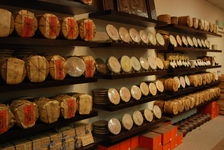
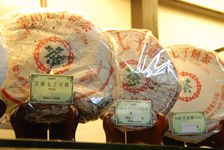
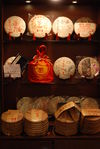
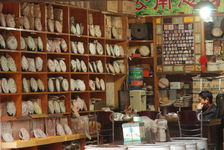
- 1.Shelving puerh (Pu Er tea) Malaysia (Purple Cane)
- 2.elderly patties stored in Hong Kong (The Best Tea House)
- 3.puerh teas in a shop in Taiwan
- 4.Tea stored in Yunnan Kunming sold
But even more than the places, the way in which we apprehend storage puerh (Pu Er tea) tea will have a decisive influence on the development of tea. And regions such as Hong Kong, Taiwan, and Yunnan do not have the same culture of puerh (Pu Er tea) tea or taste the same, and do not store tea in the same way, over the years lead to significantly different teas. Indeed, if it there's a very significant difference between climate eg Hong Kong and Taiwan, these differences are insignificant compared to the influence of storage methods, for example to the humidity difference within a ventilated stock and a stock that can take care of seal.
Finally, in addition to the issue of climate change and cultural specificity of these regions, we must also consider the quality of storage, and if some large well stocked raw became sublime after year, the same teas stored with less care or so often find themselves less suitable dishes and empty of interest. The Shui Lan Yin I have chosen to illustrate this article is therefore one of the best I've ever had, and truly deserves to be up to the reputation of this cake. After a few short years of natural storage in Hong Kong, this cake was stored carefully in a great natural dry storage Taiwan. Following in the cup.
 Chargement du thé...
Chargement du thé...
